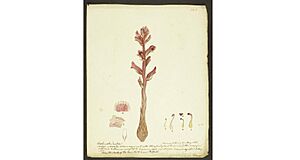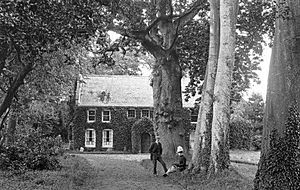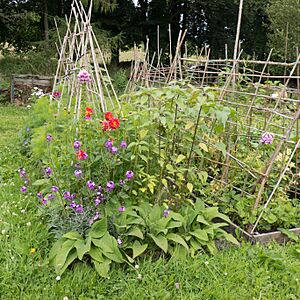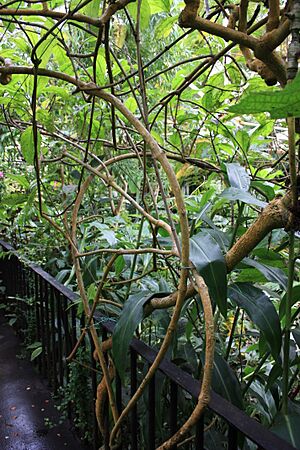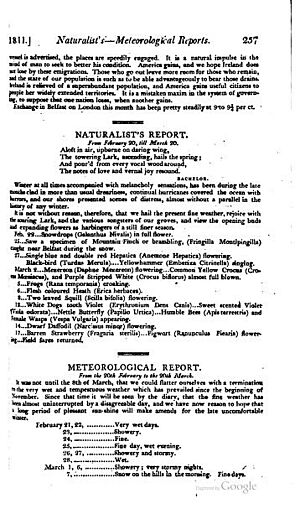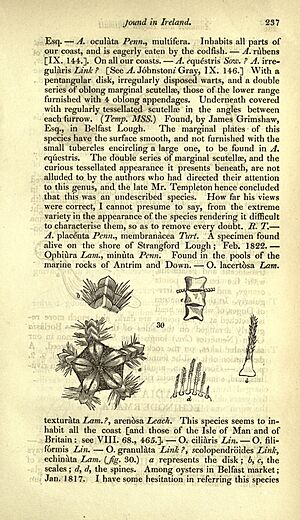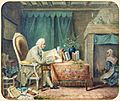John Templeton (botanist) facts for kids
John Templeton (1766–1825) was a very important Irish naturalist. Some people even call him the "Father of Irish Botany" because he studied plants so much. He was a key person in Belfast during the late 1700s, a time when new ideas and scientific discoveries were very popular. He was also involved with the Society of United Irishmen for a while and was active in Belfast's science and literature groups.
Contents
John Templeton's Family Life
John Templeton was born in Belfast in 1766. His father, James Templeton, was a successful merchant, and his mother was Mary Eleanor. The family lived in a large old house called Orange Grove. This house was named after William of Orange, who had visited it before a famous battle in 1690.
John went to a special school until he was 16. This school was known for its modern teaching style, mixing lessons with play and hands-on learning. Many children from liberal families in Belfast went there. John became good friends with his schoolmates Henry Joy and Mary Ann McCracken, and they stayed friends for life.
In 1799, John married Katherine Johnson. Her family had been affected by the Irish Rebellion of 1798 the year before, as her brother-in-law had been involved. John and Katherine had five children: Ellen, Robert, Catherine, Mary, and Matilda.
Because both their families were wealthy, John had plenty of money. This allowed him to spend all his time studying natural history, which he loved very much.
His Time with the United Irishmen
Like many people in Belfast at the time, John Templeton agreed with the goals of the Society of United Irishmen. They wanted Catholics to have equal rights and for the Irish Parliament to be more democratic. After some time, he decided to join them.
To show his support for a united Ireland, John changed the name of his family home from Orange Grove to "Cranmore." This Irish name means "big tree."
However, John was disappointed by the Irish Rebellion of 1798. He didn't like the violence that happened. He even left the Belfast Literary Society because one of its members, Dr. James MacDonnell, had helped capture a rebel leader who was John's friend. Even though he couldn't forget his friend, John later made peace with Dr. MacDonnell.
His Amazing Garden
John Templeton had a huge 13-acre garden at Cranmore. He filled it with many different kinds of plants, both local and exotic. He got these plants from his trips, from other botanists, from nurseries, and even from other countries like North America, Australia, India, and China.
His garden was also like a small farm where he experimented with raising animals. He also had a kitchen garden to grow food.
John Templeton, the Botanist
John Templeton's interest in plants started with his special garden. He grew many delicate plants outdoors and began studying botany (the study of plants). He corresponded with famous botanists in England, like Sir William Hooker and Sir Joseph Banks. Banks, who had traveled with Captain James Cook, even tried to convince John to go to Australia as a botanist, offering him land and a good salary, but John didn't go.
John was a member of the Linnean Society, a group for naturalists. He visited London to see the botanical work there. This inspired him to help start the Belfast Botanic Gardens in 1809.
He also worked on a "Catalogue of Native Irish Plants," which was a detailed list of plants found in Ireland. This list was very accurate and helped later Irish botanists. He also started a book called "Flora Hibernica" with beautiful watercolor drawings, but he never finished it. He also kept a detailed journal from 1806 to 1825.
The Ulster Museum has many of John Templeton's plant specimens, especially algae. He collected most of these himself.
John Templeton was the first person to find a special rose called Rosa hibernica in 1795. He wrote about it in 1803. He also discovered many other plants in Ireland, like Adoxa moschatellina and Orobanche rubra. His work on lichens (a type of fungus and algae living together) was very important for other botanists.
His Writings and Drawings
John Templeton left behind seven volumes of manuscripts (handwritten books). One small book, now in the Royal Irish Academy, lists many non-flowering plants like mosses and their locations.
The other six volumes are larger and contain over a thousand pages. They have descriptions of plants and beautiful, detailed drawings made with pen, pencil, and colors. These drawings are very accurate and artistic, especially those of mosses. These volumes are now kept at the Ulster Museum, Belfast.
Even though John Templeton's work was very important, it wasn't widely known for a long time. Later botanists used his notes and drawings, but his full collection of manuscripts wasn't described until much later.
Plants He Discovered
John Templeton found many interesting plants across Ireland. Here are just a few examples:
- In Antrim: Northern beech fern (Glenaan River, 1809), intermediate wintergreen (Sixmilewater, 1794), dwarf willow (Slievenanee Mountain, 1809), Dovedale moss (Cave Hill, 1797), Arctic root (Slemish Mountain, before 1825).
- In Down: Field Gentian (Slieve Donard, 1796), Lesser Twayblade (Newtonards Park, before 1825), Rough poppy (1797), Great Sundew (near Kilkeel, 1808), Hairy Rock-cress (Dundrum Castle, 1797), Scots Lovage (Bangor Bay, 1809).
- In Fermanagh: Marsh Helleborine.
His Study of Irish Nature
John Templeton was interested in many areas of science. He studied chemistry related to farming, meteorology (weather), and phenology (the study of seasonal natural events). He didn't publish much, except for monthly reports on nature and weather in the 'Belfast Magazine'.
He also studied birds a lot, collected shells, sea creatures (especially "Zoophytes"), and insects, including garden pests. He planned to write a book about Irish animals, similar to his plant book, but it was never published. However, some of his work on animals was later put together and published by his son, Robert Templeton.
Much of John's work was used by later naturalists, especially William Thompson, whose book 'The Natural History of Ireland' continued John's important studies.
His Visits to Dublin
John Templeton often visited Dublin, which was a beautiful city. He was a member of the Royal Dublin Society. By the time he died in 1825, this society had created a Botanic Garden at Glasnevin with many different sections, including:
- A garden arranged by the Linnaeus system.
- A garden arranged by the Jussieu system.
- A garden for plants native to Ireland.
- A kitchen garden where apprentices learned about botany.
- Sections for medicinal plants, plants for animals, plants for farming, and plants for dyeing.
- Special areas for rock plants, water plants, and mosses.
He was also connected with Leinster House, which had the Royal Dublin Society's museum and library. The museum had many animal specimens, including mammals, birds, reptiles, fish, insects, and worms. It also had a large collection of shells, butterflies, and beetles. The library had 12,000 books, especially on botany.
John Templeton was also involved with other groups like the Farming Society and the Kirwanian Society. He visited Marsh's Library, the Trinity College Botanic Garden, the Trinity Library, and the Trinity Museum.
His Lasting Impact
John Templeton was never very strong and had poor health from 1815. He passed away in 1825 at the age of 60. He left behind his wife, young children, and many friends who missed him greatly. A type of plant from Australia, Templetonia, was named after him to honor his work.
In 1810, John helped start the Belfast Academical Institution. He also helped form the Belfast Natural History and Philosophical Society, which led to the creation of both the Botanical Gardens and what is now the Ulster Museum.
Even though John Templeton didn't publish many books, he was always happy to share his discoveries. Robert Lloyd Praeger, a famous Irish naturalist, called him "the most eminent naturalist Ireland has produced."
John's son, Robert Templeton (1802-1892), also became a naturalist. He was known for his work on insects from Sri Lanka.
People He Knew
John Templeton had many important contacts in the world of natural history. He shared his findings and ideas with:
- Thomas Martyn
- George Shaw
- James Edward Smith
- James Lee
- Samuel Goodenough
- Aylmer Bourke Lambert
- James Sowerby
- William Curtis
- Joseph Banks
- Robert Brown
- Lewis Weston Dillwyn
- Dawson Turner
- John Walker
- Francis Rawdon-Hastings, 1st Marquess of Hastings
- John Foster, 1st Baron Oriel
- Jonathan Stokes
- Walter Wade
Other Interests
John Templeton had a special cabinet where he kept natural history specimens from places like Calobar, Australia, and The Carolinas, as well as Ireland. His library included important scientific books by Carl Linnaeus and others. He used a John Dollond microscope for his studies. He also traveled to Scotland and recorded observations of comets in his diaries, like the Comet of 1807 and the Great Comet of 1811.
Images for kids
-
A Linnaean garden where plants are arranged by the Systema Naturae order
See also


